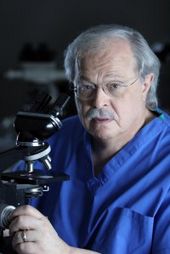
© Courtesy of HBOMichael Baden
Redacting the names of pathologists is not normal in either civilian or military practice. It is necessary to know the pathologists' names to be able to evaluate their qualifications, certifications, and experience. This may also help the family assess whether a second autopsy should be done. Mistakes can be made. Supreme Court Justice Antonin Scalia, in a recent decision establishing a right to cross-examine forensic experts, wrote that "A forensic analyst responding to a request from a law enforcement official may feel pressure - or have an incentive - to alter the evidence in a manner favorable to the prosecution." Science must remain independent of politics. It is necessary that names of the pathologists be known to the family for accountability purposes.
2. Do deaths in the context of confinement in prison raise any special concerns for a medical examiner conducting an autopsy?Yes, a death in prison raises a special set of concerns that are not present when a person dies at liberty. The prison keepers have a duty to care for and protect prisoners. They must provide a reasonable level of health care, and they must address mental health issues of prisoners. They need to ascertain whether a prisoner has suicidal tendencies, and if so, they have to develop strategies to prevent suicide such as security cameras or one-on-one observation. A medical examiner presented with a death in prison needs to independently determine the cause and manner of death and how it happened so that such deaths can be prevented in the future.
3. It appears that the autopsies of the three Guantanamo prisoners were commenced within one day of their deaths and that no effort was made to notify their families or secure permission for an autopsy. Does this strike you as normal procedure?The steps that were taken to conduct these autopsies need to be measured against the rules that had been established for deaths at the prison. Family permission is not needed in these circumstances. However, it is always proper procedure to notify the next of kin of a death and of the decision to conduct an autopsy. The next of kin will need to arrange removal and burial, or may also arrange for a second autopsy. Should there be religious objections to an autopsy, explanations should be provided as to why the autopsy was necessary.
4. The throats and internal organs were removed from all three prisoners and were not turned over to the families together with the remainder of the bodies. A lawyer acting for one of the families wrote a letter to Armed Forces Institute of Pathology demanding the missing materials, but thus far has been unable to examine them. Does this strike you as irregular?When an autopsy is finished, all organs are normally returned to the body except those necessary for further tests, such as toxicology or histology. In cases where death is attributed to neck compression, as here, the neck organs may also be retained for further study. The families of the deceased always have the right to have a second autopsy performed. Properly qualified pathologists representing the families should be able to examine any organs retained and not present in the body at the time it is turned over. If the pathologists who conducted the first autopsy still need those parts for testing or examination, they should make them available to the pathologist conducting the second autopsy - either by sending the removed parts to the pathologist, or by allowing the pathologist to examine the parts at the site where the organs have been kept. It is not appropriate to be unresponsive to the pathologists conducting the second autopsy. If the body parts that were removed have been properly preserved, they can still be examined years later to assist in independently establishing how the death occurred.
5. One of the autopsy reports notes that the hyoid bone was broken, but it states that this occurred accidentally in the process of removing the throat. Do you attach any significance to these facts?Yes. A fracture of the hyoid bone occurs more commonly in homicidal manual strangulation than in suicidal hanging. A pathologist performing the second autopsy should be able to examine the hyoid bone and larynx to independently determine if the fracture happened while the decedent was alive or inadvertently after death during autopsy removal of the larynx.
6. The government has accounted for the presence of rags in the mouths of the three prisoners by suggesting that they stuffed the rags in their own mouths to muffle noise which might alert guards, and that the rags were "inhaled as a natural reaction to death by asphyxiation." Are you familiar with any other cases in which prisoners committed suicide by binding their feet, binding their hands, stuffing rags down their throats (and putting on a surgical mask to keep the rags in place), and while so bound, climbing up onto something to put their heads through a noose? In your opinion, would it be appropriate for a medical examiner to reach a conclusion that rags "were inhaled as a natural reaction to death by asphyxiation?"I am not aware of any other case in which suicide was accomplished in this way, at least not with a gag in his mouth covered by a surgical mask. Occasionally someone ties his feet and wrists and then tightens a noose around his neck - but this is more common in accidental deaths during autoerotic activity than when someone intends to commit suicide.
Reader Comments
to our Newsletter